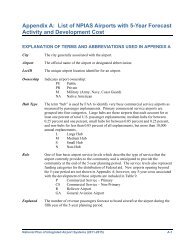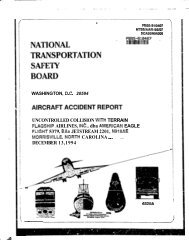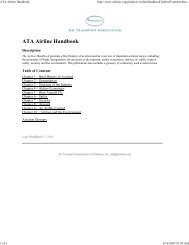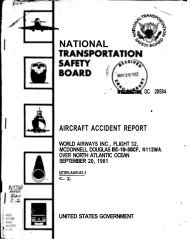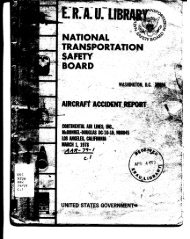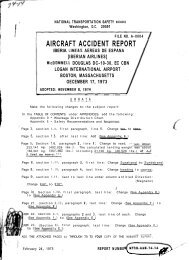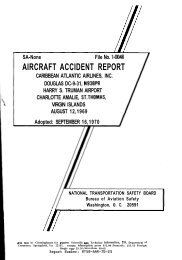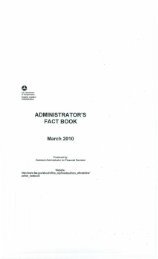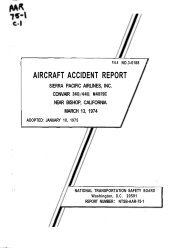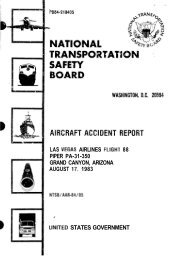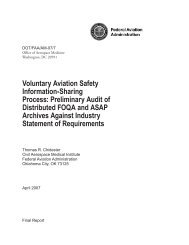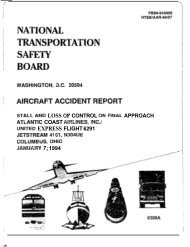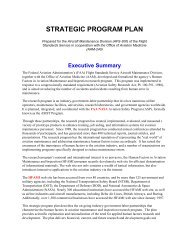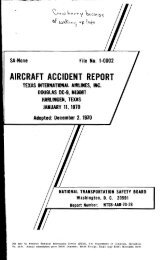NTSB/AAR-73-07 - AirDisaster.Com
NTSB/AAR-73-07 - AirDisaster.Com
NTSB/AAR-73-07 - AirDisaster.Com
You also want an ePaper? Increase the reach of your titles
YUMPU automatically turns print PDFs into web optimized ePapers that Google loves.
File N0.A-0001<br />
AIRCRAFT ACCIDENT REPORT<br />
Jugoslovenski Aerotransport [JAT)<br />
Boeing 7<strong>07</strong>-321, YU-AGA<br />
John F. Kennedy International Airport<br />
Jamaica, New York<br />
August 13, 1972<br />
Adopted: April 4, 19<strong>73</strong><br />
NATIONAL TRANSPORTATION SAFETY BOAR0<br />
Washington, D.C. 20591<br />
REPORT NUMBER: <strong>NTSB</strong>-<strong>AAR</strong>-<strong>73</strong>-7
TECHNIC<br />
. Report No. I 2.Government Accession No.<br />
<strong>NTSB</strong>-<strong>AAR</strong>-<strong>73</strong>-7<br />
. Title and Subtitle Jugoslovenski Aerotransport<br />
:JAT) Boeinx - 7<strong>07</strong>-321, YU-AGA. John F. ~~~~~d~<br />
~ ~I<br />
[nternational Airport, Jamaica, New York,<br />
4ugust 13, 1972<br />
. Author(s)<br />
8 . Performing Organization Name and Address<br />
National Transportation Safety Board<br />
Bureau of Aviation Safety<br />
Washington, D. C. 20591<br />
2.Sponsoring Agency Name and Address<br />
NATIONAL TRANSPORTATION SAFETY BOARD<br />
Washington, D. C. 20591<br />
5.Supplementary Notes<br />
L REPORT STANDARD TITLE PAGE<br />
3.Recipient's Catalog No.<br />
5.Report Date<br />
April 4, 19<strong>73</strong><br />
6.Perforrnina - Oraanization -<br />
Code<br />
8.Performing Organization<br />
Report No.<br />
10.Work Unit No. 1058<br />
11.Contract or Grant No.<br />
13.Type of Report and<br />
Period Covered<br />
Aircraft Accident Report<br />
August 13, 1972<br />
14.Sponsoring Agency Code<br />
l6.Abstract On August 13, 1972, at 0050 eastern daylight time, while aborting a<br />
takeoff from Runway 13R, John F. Kennedy International Airport, Jamaica, New<br />
York, Jugoslovenski Aerotransport (JAT) Flight 3410 ran off the end of the runway.<br />
There were 175 passengers and a crew of 11 aboard the aircraft at the time<br />
of the accident; 15 passengers and a steward were injured during evacuation.<br />
During the takeoff, the right cockpit sliding window came open, and made a<br />
loud noise. The captain initiated action to reject the takeoff. The aircraft ran off<br />
the end of the runway, struck the blast fence, and came to a stop approximately<br />
120 feet from the end of the paved surface and 80 feet to the right of the runway.<br />
The left wing and engines Nos. 1 and 2 were damaged by impact and the ensuing<br />
fire. The crew and passengers successfully evacuated the aircraft by means of the<br />
emergency slides.<br />
The National Transportation Safety Board determines that the probable cause<br />
of this accident was the unknown degraded capability of the heavily loaded air-<br />
craft's braking system, which precluded stopping the aircraft within the runway<br />
distance available. the reduced braking capability resulted from a malfunctioning<br />
V-3 relay in the left antiskid control shield of the aircraft's braking system, which<br />
rendered two of the eight-wheel brakes ineffective. A sound like that of an ex-<br />
plosion in the cockpit during the takeoff roll caused the captain to reject the takeoff,<br />
17. Key Words 18.Distribution Statement<br />
Aircraft accident, Aborted takeoff, Antiskid system<br />
Wheel brakes, Fire damage, Faulty V-3 relay, Release to public;<br />
8-wheel brake configuration, 6-wheel brake<br />
distribution unlimited.<br />
configuration<br />
19.Security classification 20.Security Classification 21.No. of Pages 22.Price<br />
(of .~ this reoort) (of this oaae)<br />
~ ~ ~r~ ~. .~ ~<br />
~
1 .<br />
1.1<br />
1.2<br />
1 . 3<br />
1.4<br />
1.5<br />
1.6<br />
1.7<br />
1.8<br />
1.9<br />
1.10<br />
1.11<br />
1.12<br />
1 . 13<br />
1 . 14<br />
1 . 15<br />
2 .<br />
2.1<br />
2.2<br />
3 .<br />
JUGOSLOVENSKI AEROTRANSPORT (JAT)<br />
BOEING 7<strong>07</strong>.321. YU-AGA<br />
JOHN F . KENNEDY INTERNATIONAL AIRPORT<br />
JAMAICA. NEW YORK<br />
AUGUST 13. 1972<br />
TABLE OF CONTENTS<br />
Synopsis .......................................<br />
Investigation ...................................<br />
History of the Flight ............................<br />
Injuries to Persons ..............................<br />
Damage to Aircraft ..............................<br />
Other Damage ..................................<br />
Crew Information ...............................<br />
Aircraft Information .............................<br />
Meteorological Information .......................<br />
Aids to Navigation ...............................<br />
<strong>Com</strong>munications .................................<br />
Aerodrome and Ground Facilities .................<br />
Flight Recorders ................................<br />
Wreckage ......................................<br />
Fire ...........................................<br />
SurvivalAspects ................................<br />
TestandResearch ..............................<br />
Analysis and Conclusions ........................<br />
Page<br />
7<br />
7<br />
7<br />
7<br />
8<br />
9<br />
9<br />
10<br />
13<br />
Analysis ...................................... 13<br />
.elusions.................................... 18<br />
Findings ................................... 18<br />
Probable Cause ............................ 20<br />
Recommendations ............................... 21<br />
Appendices<br />
Appendix A Investigation and Hearing ...... 22<br />
Appendix B Crew Information ............. 23<br />
Appendix C Aircraft History ............... 26<br />
Appendix D Airport Diagram .............. 27<br />
iii<br />
1<br />
2<br />
2<br />
4<br />
5<br />
5<br />
5<br />
5<br />
6
Adopted: April 4, 19<strong>73</strong><br />
NATIONAL TRANSPORTATION SAFETY BOARD<br />
WASHINGTON, D. C. 20591<br />
AIRCRAFT ACCIDENT REPORT<br />
JUGOSLOVENSKI AEROTRANSPORT (JAT)<br />
BOEING 7<strong>07</strong>-321, YU-AGA<br />
JOHN F. KENNEDY INTERNATIONAL AIRPORT<br />
JAMAICA, NEW YORK<br />
AUGUST 13, 1972<br />
SYNOPSIS<br />
File No. A-0001<br />
Jugoslovenski Aerotransport (JAT) Flight 3410 was involved in an<br />
accident on August 13, 1972, at 0050 eastern daylight time during a re-<br />
jected takeoff from Runway 13R at the John F. Kennedy International<br />
Airport, Jamaica, New York. There were 175 passengers and a crew<br />
of 11 aboard the aircraft at the time of the accident; 15 passengers and<br />
a steward were injured during the evacuation from the aircraft.<br />
During the takeoff, the right cockpit sliding windown came open,<br />
which made a loud noise. This action occurred 3 seconds after the co-<br />
captain had called VI. The captain initiated action to reject the takeoff.<br />
The aircraft ran off the end of the runway, struck the blast fence, and<br />
came to a stop approximately 120 feet from the end of the paved surface<br />
and 80 feet to the right of the runway. The left wing and engines Nos. 1<br />
and 2 were damaged by impact and the ensuing fire. The crew and<br />
passengers successfully exited the aircraft.<br />
The emergency equipment from the Port of New York and New<br />
Jersey Authority arrived on the scene in approximately 4 minutes and<br />
extinguished the flames.<br />
The National Transportation Safety Board determines that the<br />
probable cause of this accident was the unknown degraded capability<br />
of the heavily loaded aircraft's braking system, which precluded<br />
stopping the aircraft within the runway distance available. The reduced<br />
braking capability resulted from a malfunctioning V-3 relay in the left<br />
antiskid control shield of the aircraft's braking system, which rendered<br />
two of the eight-wheel brakes ineffective. A sound like that of an ex-<br />
plosion in the cockpit during the takeoff roll caused the captain to reject<br />
the takeoff.
1. 1 History of the Flight<br />
- 2 -<br />
1. INVESTIGATION<br />
Jugoslovenski Aerotransport (JAT), a Boeing 7<strong>07</strong>-321, YU-AGA,<br />
operating as Flight 3410 (JU3410) on August 13, 1972, was scheduled<br />
from the John F. Kennedy (JFK) International Airport to the Rijeka<br />
Airport, Rijeka, Yugoslavia.<br />
JU3410 was an international operation transporting a charter<br />
group of 175 passengers from the United States to the Island of Krk on<br />
the Northern Adriatic Sea Coast of Yugoslavia and was scheduled for<br />
departure at 23301/3 August 12, 1972. The actual departure from the<br />
British Overseas Airways Corporation (BOAC) terminal gate was at<br />
0023:45.<br />
The aircraft ran off the end of the 14,572-foot Runway 13R and<br />
impacted the blast fence at the end of the runway during an attempt to<br />
reject the takeoff.<br />
An International Instrument Flight Rules flight plan was filed for<br />
JU3410 by the Pan American World Airways (PAA) New York dispatch<br />
office from JFK to Shannon, Ireland. This dispatching was done under<br />
contract arrangements between PAA and JAT. The crew's stated in-<br />
tention was to refile in-flight over Shannon for Rijeka or an alternate,<br />
depending on weather conditions.<br />
The flight dispatch release for JU3410 of August 13, 1972, was<br />
prepared and signed by the PAA dispatcher on duty. The dispatch re-<br />
lease was valid until 0030. However, in order for such a release to<br />
be in effect, it was necessary for the captain of the flight tq sign,<br />
indicating that he concurred with the dispatcher that the contemplated<br />
operation could be safely conducted under the prevailing and forecast<br />
conditions. The captain did not sign the dispatch release for JU3410<br />
of August 13, 1972.<br />
The crew prepared a Yugoslav Airlines loadsheet at the BOAC<br />
Terminal and increased the fuel loading indicated on the PAA dispatch<br />
~~~~~ ~~ ~ ~ ~<br />
-<br />
1/ All times herein are eastern daylight, based on the 24-hour clock.
A,<br />
I<br />
m<br />
he<br />
I<br />
0<br />
!or<br />
ch<br />
ier<br />
1-<br />
e,<br />
.s<br />
'e-<br />
3<br />
ed<br />
st<br />
0<br />
_.<br />
2<br />
:ch<br />
-<br />
:k.<br />
-3-<br />
release from 108, 900 pounds to 137, 000 pounds. This fuel, less 2, 000<br />
pounds necessary for taxi, placed the calculated gross weight of the air-<br />
craft at its maximum structural weight limit of 312, 000 pounds for this<br />
takeoff. The PAA Dispatcher was not informed of these changes.<br />
Upon boarding the aircraft, and during the cockpit check of the<br />
aircraft, the crew listened to the ATIS ?I "Zulu, " effective at 2251,<br />
August 12, 1972, which announced, among other airport data, that the<br />
wind was 220' (magnetic) at 8 knots. Neither the JFK Tower Ground<br />
Controller nor the JFK Local Controller volunteered any information<br />
that the wind was other than as had been given in the effective ATIS<br />
broadcast. The actual wind, as recorded by the National Weather<br />
Service at 0051, August 13, 1972, was 220° True (210° magnetic) at<br />
8 knots.<br />
BOAC, also working under contract with JAT, performed the air-<br />
craft preparation (i. e., fueling, maintenance release, required ramp<br />
maintenance, aircraft loading, etc., as well as passenger handling) for<br />
the flight.<br />
The crew calculated the aircraft total weight at the beginning of<br />
the takeoff to be 311,725 pounds. The takeoff reference speeds<br />
(V speeds)^ 21 for an aircraft of this weight with a temperature of 71°F.<br />
(21OC. ) would be:<br />
V1 - 150 knots<br />
VR - 160 knots<br />
Vz - 170 knots<br />
These speeds were obtained from the aircraft's operating manual<br />
and were placed on the takeoff data card by the flight engineer.<br />
At 0015:20, the cocaptain for the flight, who was occupying the<br />
right seat and who was performing the duties of the copilot, called the<br />
JFK Clearance Delivery Controller for the flight clearance.<br />
- 21 ATIS - Automatic Terminal Information Service.<br />
21 V Speeds - VI - critical engine failure speed.<br />
VR - rotation speed.<br />
V2 - takeoff safety speed.
-4-<br />
At 0020:00, the cocaptain called JFK Ground Control for pushback<br />
from the BOAC Terminal and asked for taxi clearance to Runway 13R.<br />
Runway 22R was in use at this time; however, JU3410, at the existing<br />
gross weight and the existing temperature, would have been at the maxi-<br />
mum limit for a takeoff from the 11, 350-foot Runway 22R. The crew<br />
requested the use of the 14, 572-foot Runway 13R. This request was<br />
granted and the flight was cleared to taxi to Runway 13R at 0026.<br />
At 0047:50, JU3410 was cleared into position to hold on Runway<br />
13R and at 0049:05, the flight was cleared for takeoff.<br />
As the aircraft accelerated, the cocaptain called 80 knots airspeed,<br />
followed 25 seconds later by the V1 call. Three seconds after the V1<br />
call, the right cockpit sliding window opened, and created a loud noise.<br />
The captain immediately initiated the reject takeoff procedures,<br />
deployed speed brakes, selected reverse thrust, and placed 100 percent<br />
N12/ on all four engines, and then applied the main wheel brakes. The<br />
aircraft continued along the runway and left tire skid marks for about the<br />
last 1. 2 statute mile (see Appendix D). Near the intersection of Runway<br />
13R and 4L, the skid marks arced slowly from astride the centerline to<br />
the right side of the runway. The aircraft ran off the right side of the<br />
paved surface at the end of the runway. The aircraft then continued<br />
through the blast fence to a point 120 feet from the end and 80 feet to the<br />
right of the runway. The aircraft came to a stop with the left outboard<br />
wing section engulfed in flames. The engines were shut down, and the<br />
fire extinguishing systems were activated for the Nos. 1 and 2 engines.<br />
The captain exited from the aircraft through the cockpit left sliding<br />
window to keep the passengers away from the fire and to expedite their<br />
movement away from the burning aircraft. The other flight crewmembers<br />
went to the passenger cabin to assist in passenger evacuation.<br />
1.2 Injuries to Persons<br />
Injuries Crew Passengers Other<br />
Fatal 0 0 0<br />
Nonfatal 1 15 0<br />
None 10 160<br />
- 41 N1 - engine low-pressure turbine speed.
e<br />
:rs<br />
1.3 Damage to Aircraft<br />
- 5 -<br />
The nose cowl sections of the Nos. 1 and 2 engines and the outboard<br />
section of the left wing received major damage in impacting the blast<br />
fence, and the left wing, outboard of the No. 2 engine was damaged by<br />
fire. The front and rear tires on the Nos. 2, 3, and 4 tandem wheels - 51<br />
were flat and all but one tire contained evidence of even wear. All of the<br />
tires had tread remaining on the carcasses, and only the No. 3 rear tire<br />
had a "flat" spot worn into the cords of the tire body.<br />
1.4 Other Damage<br />
Thirty feet of the steel blast fence at the end of Runway 13R/31L<br />
was destroyed. Several frangible fittings, located about midway up the<br />
support brackets of the blast fence structure were separated by the<br />
impact.<br />
1. 5 Crew Information<br />
The crewmembers were certificated in accordance with existing<br />
Yugoslavian regulations and International Civil Aviation Organization<br />
(ICAO) standards to perform the duties of flight crewmembers for this<br />
flight. (See Appendix B for details. )<br />
1. 6 Aircraft Information<br />
Aircraft YU-AGA, A boeing 7<strong>07</strong>-321, serial No. 17601 was leased<br />
by the Jugoslovenski Aerotransport (JAT) from the GATX Bulk Carrier<br />
Number Three of Monrovia, Liberia. The aircraft formerly had been<br />
owned and operated by PAA under United States Registry N723PA. At<br />
the time of the accident, the aircraft was registered in Yugoslavia.<br />
(See Appendix C for details. )<br />
The aircraft cabin configuration had 177 passenger seats and four<br />
cabin crewmember jump seats.<br />
The maximum design takeoff gross weight was 312, 000 pounds.<br />
The center of gravity limits for the loading of this aircraft in a<br />
passenger configuration were 21 percent forward and 35 percent aft<br />
-<br />
5/ The main landing gear consists of eight wheels that are arranged in<br />
a tandem series and are numbered from left to right.
.<br />
- 6 -<br />
Mean Aerodynamic Chord (MAC). The stabilizer trim was set at "21"<br />
during completion of the pretakeoff checklist. The trim setting was<br />
found at 22 percent MAC after the accident.<br />
All baggage and spare parts were weighed after the accident.<br />
These weights, passenger normal weights, plus other operational<br />
weights (fuel, oil, crewmembers, etc. ) combined to a calculated<br />
gross weight of about 311, 000 pounds at the time the brakes were re-<br />
leased to commence the takeoff.<br />
1. 7 Meteorological Information<br />
JU3410 had been provided with meteorological data pertinent to<br />
the PAA computer flight plan to Shannon, Ireland, with an alternate of<br />
Heathrow Airport, London, England. No weather information was<br />
provided by PAA to the crew for the continuation of the flight from<br />
Shannon, Ireland, to Rijeka, Yugoslavia.<br />
The crew, after boarding the aircraft, received the Kennedy<br />
Airport Terminal Information Service, as follows:<br />
"This is Kennedy Departure Information Service with<br />
Information ZULU. Departure Runway 22R. Wind<br />
220' 6_/ at 8. Altimeter 30. 08. Temperature 71° at<br />
0251 Z . "<br />
ATIS information was the only local weather provided to the<br />
crew after they had boarded the aircraft.<br />
The National Weather Service 0051 local weather observation<br />
was in part:<br />
Ceiling measured 4,600 feet broken, 25, 000 broken,<br />
visibility 8 miles, temperature 71° F., dewpoint 62O F.,<br />
wind 220' 7/ 8 knots, altimeter setting 30. 08 inches.<br />
- 61 Wind is reported by magnetic direction by tower personnel.<br />
- 71 Wind was recorded by true direction by weather observers.<br />
The magnetic variation for the JFK area was loo W.
1. 8<br />
1.9<br />
-7-<br />
The local weather observation taken at 0101 was:<br />
Ceiling measured 4,600 broken, 25, 000 broken,<br />
visibility 8 miles, temperature 70' F., dewpoint<br />
62O F., wind 220°, 7 knots, altimeter 30. 08,<br />
remarks - aircraft accident.<br />
Aids to Navigation<br />
Not involved.<br />
<strong>Com</strong>munications<br />
No difficulties with communications between the flight and the air<br />
traffic control facilities were reported.<br />
1.10 Aerodrome and Ground Facilities<br />
Runway 13R/31L at the John F. Kennedy International Airport is<br />
14,572 feet long and 150 feet wide. The runway is constructed of con-<br />
crete and has a Federal AviationAdministration (FAA) gross weight<br />
strength limitation of 340, 000 pounds for an aircraft with dual wheel<br />
tandem design. The surface of the runway contains numerous repair<br />
patches of an asphaltic material. The runway profile of 13R is<br />
undulating .<br />
Steel blast fences were listed on the FAA Airport Master Record<br />
dated September 21, 1970, at 13R/31L; however, the only blast fence<br />
on this runway is at the end of Runway 31L.<br />
Runway 13R was equipped with high-intensity runway lights that<br />
were controlled by a five-step intensity selector switch in the tower.<br />
The lights were set on "Step 1" which was the lowest intensity setting.<br />
All runway lights were operating at the time of the accident.<br />
1.11 Flight Recorders<br />
YU-AGA was equipped with a Lockheed Aircraft Service Co.,<br />
Model 109-C Flight Data Recorder (FDR) and it was operatinx.<br />
The altitude trace was constant and consistent with the runway<br />
elevation.
-8-<br />
The airspeed trace showed an increasing airspeed from the time<br />
of brake release for a period of 54 seconds, attaining a maximum of<br />
154 knots. The speed was then relatively constant for 3 seconds,<br />
followed by a constant rate of decline for 18 seconds, down to 70 knots.<br />
There were erratic excursions of the airspeed trace during the ensuing<br />
3 seconds down to a speed of 34 knots, a straight-line excursion for<br />
4 seconds, and a decrease in speed to 32 knots in the next 2 seconds.<br />
The trace then resumed approximately the same rate of decrease that<br />
was shown from 154 knots down to 70 knots and continued to decrease<br />
to about 10 knots; the rate of decrease then flattened and the speed de-<br />
creased from 10 knots to 8 knots in 4 seconds.<br />
The aircraft was also equipped with a Fairchild Model A-100 Cock-<br />
pit Voice Recorder. The unit and the tapes were undamaged by the<br />
accident, and a transcription of the voices and sounds, commencing at<br />
the time of the crew's initial call to the JFK Tower, was made.<br />
The tape disclosed that at 0049:05.5, JU3410 was cleared for<br />
takeoff and at 0049:26. 5, the captain stated, "Let's go. " The cocaptain,<br />
23. 7 seconds later, called 80 knots, and 24. 03 seconds later, the VI.<br />
Three seconds after the V1 call, the noise of an explosion, followed by<br />
a continuing roar, was recorded. During the next 43 seconds, until the<br />
aircraft came to a stop, the following comments were recorded<br />
sequentially: "Window open . . . engine down . . . speed brakes . . .<br />
reverse . . . all reverse. "<br />
1. 12 Wreckage<br />
The aircraft sustained extensive damage to the left outboard wing<br />
panel, left aileron, and the left outboard wing flap as the result of im-<br />
pact with the steel blast fence and the ensuing fire.<br />
The nose cowl sections of the Nos. 1 and 2 engines were crushed<br />
rearward to the compressor fan inlet area of the engines.<br />
The lower wingskin between the No. 2 engine and the No. 1 engine<br />
was severely damaged by impact.<br />
The Nos. 2, 3, and 4 front and rear brakes had been subjected to<br />
extremely high internal heat. The disc lugs for these brakes had been<br />
sheared and pieces of the lugs were found in the wheel slots. Numerous<br />
brake return springs were missing from these brakes; several were<br />
found along the runway, about 1, 000 feet prior to the end of 13R.
1. 13 Fire<br />
- 9 -<br />
A fire engulfed the left outer wing panel outboard of the No. 2<br />
engine following impact of the aircraft with the blast fence. The left<br />
fuel tank was ruptured, and a ground fire developed from the spilled<br />
fuel.<br />
1.14 Survival Aspects<br />
The aircraft came to a stop in the sand off the end and to the right<br />
of the runway. Fires started in engines Nos. 1 and 2, the left outboard<br />
wing section, and on the ground underneath the left wing.<br />
Five crewmembers occupied the cockpit, and six cabin attendants<br />
were stationed in the cabin. The cabin attendants were stationed as<br />
follows: two on the aft-facing jumpseat by the forward entry door, two<br />
on the forward facing jumpseat at the aft entry door, and two in the first<br />
passenger seats on the left side of the aircraft. Passengers occupied<br />
all of the remaining seats in the cabin.<br />
A predeparture emergency briefing and information announcement<br />
was made by the No. 1 purser during the 26-minute taxi from the board-<br />
ing gate to the runway. The passengers described a bumpy takeoff roll,<br />
followed by a rough bumpy deceleration until the time the aircraft came<br />
to a stop. None of the passengers or crewmembers reported receiving<br />
any injury during this portion of the occurrence. All cabin structure<br />
and furnishings remained intact, but pillows and blankets fell from the<br />
overhead storage racks into the center aisle. Stacks of extra meal<br />
boxes, numerous canned drinks, as well as ice from ice buckets were<br />
propelled into the aisles and galley areas. These items had not been<br />
secured prior to the takeoff. Several passengers reported that these<br />
loose objects impeded their exit from the aircraft.<br />
The passengers began to evacuate the cabin on their own initiative<br />
when they observed flames outside the left side of the aircraft. No<br />
announcement was made over the public address system or the self-<br />
powered megaphones, even though this emergency equipment was avail-<br />
able in the cabin.<br />
The escape rope at the left sliding window of the cockpit, the<br />
inflatable slide at the forward entry door, and the slide at the forward<br />
galley service door were deployed and used during the evacuation of<br />
the aircraft. The slide for the aft galley service door was automatically<br />
deployed when the door was opened by the No. 4 steward; however, the
.<br />
- 10 -<br />
slide failed to inflate after he reportedly activated it. The steward and<br />
the aft purser, followed by several passengers, jumped from the aft<br />
galley exit to the ground. The distance from the floor to the ground was<br />
approximately 8 feet. A short time later, after all passengers had<br />
exited, this slide was observed to be inflated and holding pressure.<br />
Examination of this slide and its associated mechanisms after the acci-<br />
dent did not disclose a discrepancy or malfunction of any component,<br />
and there was no explanation of the failure of the slide to inflate initially.<br />
Several passengers evacuated through both overwing exists on the<br />
right side of the aircraft. No cabin crewmembers were at these exists<br />
and the escape rope was not deployed. Passengers reported that they<br />
jumped from the trailing edge of the wing, a distance of approximately<br />
5 feet, and from the leading edge of the wing, which was approximately<br />
7 feet above the ground. Eleven passengers and one stewardess re-<br />
ported that they received sprains, strains, and bruises of the extremities<br />
as a result of jumping to the ground from the right wing or the aft galley<br />
exit. No serious injuries were sustained by crewmembers or passengers<br />
as a result of the accident or as they disembarked from the aircraft.<br />
The site where the aircraft came to a stop is located 1.8 statute<br />
miles from the JFK No. 1 Airport Fire Station and 1. 9 statute miles<br />
from the JFK Satellite Airport Fire Station.<br />
The airport crash alarm was sounded by FAA Tower personnel<br />
at 0050 and the airport emergency equipment was reported to have<br />
arrived at the burning aircraft at 0054. All occupants were out of the<br />
aircraft prior to the arrival of this emergency equipment. The fire<br />
was extinguished within 5 minutes after the arrival of the emergency<br />
equipment, with a minimal amount of fire damage to the aircraft.<br />
1. 15 Test and Research<br />
The copilot's No, 2 sliding window came open 3 seconds after the<br />
aircraft had accelerated to VI. The roll pin which secures the window<br />
handle to its shaft was found withdrawn approximately a quarter of an<br />
inch. The trigger lock bolt had evidence of wear on the bottom end;<br />
the window adjusting rod was out of adjustment, shortened by one full<br />
turn of the rod; and the window handle machanism had excessive play<br />
in it. The window was checked for operation. (The normal force re-<br />
quired to place the handle in the locked position is 45 t 15 pounds. )<br />
A force of 48 to 60 pounds was required to close and lock the window.<br />
The spring-loaded trigger in the handle hung in a midtravel position,<br />
-
es<br />
Y<br />
'rs<br />
e<br />
"<br />
- 11 -<br />
and the associated trigger lockbolt did not fully engage the lockplate<br />
hole. In this condition, the window would appear to be in the closed<br />
and locked position; however, any pressure.on or movement of the<br />
handle would disengage the trigger lockbolt from the lockplate and the<br />
window could open.<br />
After the accident, a pencil, fractured in several places, was<br />
found in the window track. <strong>Com</strong>parison tests were performed by<br />
inserting a pencil in the handle trigger lockplate and cover assembly<br />
hold adjacent to the handle. The window ,was then unlocked and opened.<br />
The pencil sheared in the same manner as the one initially found in the<br />
window track. This test was performed twice with the same results.<br />
The brake-adjusting units were removed from the brake<br />
assemblies and checked for their flinctional capabilities. The units<br />
for the No. 2 forward and the No. 3 aft brake assemblies were found<br />
to have a slight hydraulic leak at high pressures. All other units were<br />
found to be normal in all aspects.<br />
A rotation check of the flywheel detectors in the brake antiskid<br />
system bekween 500 and 1500 r. p. m. indicated a brake release con-<br />
dition on the No. 1 and the No. 4 forward and aft cockpit indicators.<br />
All of the detectors were removed and functionally tested with the<br />
following results:<br />
Position<br />
No. 1 Forward<br />
No. 1 Aft<br />
Test Speed<br />
800 r. p. m.<br />
1, 000 r. p. m.<br />
Findings<br />
Checked within specified limits<br />
High skid switch resistance between<br />
Pins C-D<br />
Unit Clockwise Rotation<br />
Limits Findings<br />
.94 - 1. 37 secs. 1.48 secs.<br />
1. 18 - 1. 72 secs. 1. 76 secs.<br />
Unit Counterclockwise Rotation<br />
500 r. p. m. . 59 - .86 secs. .9l secs
- 12 -<br />
................................................................<br />
No. 2 Forward Slightly high-skid switch resistance<br />
between pins C-D and pins A-D<br />
No. 2 Aft Clockwise, clutch test indicated skid<br />
switch signal time in excess of limits<br />
No. 2 Rear Unit .Clockwise Rotation<br />
Test Speed Limits Findings<br />
500 r. p. m. .59 - .86 secs. . 90 secs.<br />
800 r. p. m. .94 -1.37 secs. 1.46 secs.<br />
________________________________________-----------.-------------<br />
No. 3 Forward Pins C-D and C-B closed circuit;<br />
unit inoperative when rotated clock-<br />
wise.<br />
No. 3 Aft Skid-deceleration rate slow<br />
No. 3 Rear Deceleration Limits Findings<br />
40 - 56 Radians 36 Radians<br />
____________. _______--------------------------.------------------<br />
No. 4 Forward Checked within specified limits<br />
No. 4 Aft Clockwise, clutch test indicated skid<br />
signal time in excess of limits<br />
No. 4 Rear Clockwise Rotation<br />
Test Speed Limits Findings<br />
500 r.p. m. .59 - .86 secs. .90 secs.<br />
800 r. p. m. .94 - 1. 37 secs. 1.45 secs.<br />
1, 000 r.p. m. 1. 18 - 1. 72 secs. 1.76 secs.
The brake system antiskid control shields were removed and<br />
functionally tested. The left control shield for the No. 1 forward and<br />
aft brakes had a defective "V-3" relay that pre.vented it from being<br />
energized. Under the circumstance.s, no matter how much pressure<br />
was applied to the brake pedals, the No. 1 front and rear brakes re-<br />
mained in a released condition.<br />
data:<br />
The Boeing <strong>Com</strong>pany provided the following brake performance<br />
1.<br />
2.<br />
Estimated energy for the six brakes working during the<br />
stop:<br />
6<br />
39.28 x 10 foot pounds per brake. This value<br />
is based on Boeing estimates of the maximum effort<br />
stopping capability with reverse thrust rather than<br />
analysis of the flight recorder data.<br />
Maximum energy level to which the brakes have been<br />
demonstrated as determined by analysis of the certifi-<br />
cation flight test data:<br />
38.7 x 10<br />
6<br />
foot pounds per brake. This is the<br />
brake energy value upon which flight manual limitation<br />
is based.<br />
The Boeing <strong>Com</strong>pany also stated that the effect of a loo change<br />
in wind direction, with the resulting 2-knot downwind component, would<br />
result in a negligible increase in the accelerate/stop distances for the<br />
aircraft.<br />
The PAA Route Manual for a B-7<strong>07</strong> on Runway 13R +t JFK shows<br />
a required maximum gross weight reduction of 5, 000 pounds (i. e.<br />
3<strong>07</strong>,000 V. 312,000) with a 2-knot tailwind at 2loC., (71'F. ). Boeing<br />
data show that the reduction of 5, 000 pounds would be necessary only<br />
if the takeoff is limited by runway length. With 14, 572 feet of runway<br />
available, no limitation on the aircraft was necessary.<br />
2. 1 Analysis<br />
2. ANALYSIS AND CONCLUSIONS<br />
The actual destination of the flight was Rijeka, Yugoslavia.<br />
Because the PAA dispatch computer does not have Rijeka, Yugoslavia
- 14 -<br />
in its system, the aircraft was dispatched to Shannon, Ireland. In this<br />
case, if the computer-predicted fuel consumption was accurate, the<br />
aircraft would have been 20,000 pounds overweight on landing at Shannon.<br />
However, JAT company procedures allow -- depending upon the fuel<br />
remaining and the existing weather conditions -- the captain to refile<br />
in the air, to another destination.<br />
The complex servicing, maintenance, and dispatching procedures<br />
being handled through contract and subcontract methods tend to remove<br />
or dilute the responsibility of the carrier for operations such as are in-<br />
volved in this accident. For example, an organization which operates<br />
an aircraft does not have the responsibility of time control on the com-<br />
ponents installed on the aircraft. Moreover, recordkeeping, replace-<br />
ment of parts, and maintenance of all types are taken care of by contract.<br />
Contractual agreement also places the responsibility for the spare parts<br />
carried aboard the aircraft on other than the operator. Finally, this<br />
method of dispatching separates the operator and his method of flight<br />
operation from the direct line control and supervision of the dispatch<br />
function. Although these areas of operational control and the observed<br />
weaknesses therein were not in the causal area of this accident, they<br />
are discussed in order that this operator, and other operators, may be<br />
aware of the possible problems of such complex arrangements.<br />
The opening of the copilot's sliding window was the initiating<br />
factor in the captain's decision to reject the takeoff.<br />
The condition of the locking mechanism in this window was such<br />
that all outward appearances convinced the cocaptain that his window<br />
was closed and locked. The facts, however, demonstrate that the<br />
locking mechanism was out of adjustment, the locking bolt trigger was<br />
hanging up in a midposition, and the locking bolt was not fully in place<br />
in the lockplate hole.<br />
Based upon the data obtained from the tests with a pencial inserted<br />
in the cover assembly hole adjacent to the handle of the sliding window,<br />
the Board concludes that the pencil was not instrumental in preventing<br />
the window from being closed or locked.<br />
The roughness and undulation of the surface of Runway 13R,<br />
discussed by the crew' while taxiing to the runway, is considered to<br />
have been a factor in the opening of the cocaptain's window during the<br />
i<br />
i<br />
t<br />
i
- 15 -<br />
takeoff, since the roughness of the runway would have been transmitted<br />
to the airframe while the aircraft was accelerating on the runway surface.<br />
This could have caused a flexing of the airframe. If the locking pin,<br />
because of the hanging trigger or the maladjustment of the locking rod,<br />
was only partially engaged, the flexing of the airframe could have been<br />
sufficient to disengage the lock completely and allow the outside air<br />
pressure to force the window open. If the aircraft had been pressurized,<br />
the positive pressure inside the aircraft would have resisted, if not<br />
totally overcome, the outside air pressure that was created by the<br />
velocity of the aircraft. This pressurization could have held the window<br />
in the closed position. Since the pressurization of the aircraft increases<br />
as soon as the aircraft leaves the ground, and the window is a plug type<br />
installation, it is probable, according to the aircraft manufacturer, that<br />
the cocaptain could have closed the window in flight. This could have<br />
been accomplished only if he were able to move the window into the<br />
window opening from a fully retracted position. If this condition could<br />
have been met, the positive air pressure inside the aircraft would then<br />
have assisted him in closing the window. This condition is purely<br />
analytical because the captain, before the cocaptain called, "Window-<br />
open, " had initiated rejected takeoff procedures, and the problem was<br />
then confined to stopping the aircraft.<br />
All pilots are keenly aware of the possibility of an explosive device<br />
being placed on board their aircraft. Any loud sound can logically cause<br />
a reflex reaction by a pilot to keep his aircraft on the ground if he has<br />
not yet lifted off. The pilot usually has no way of assessing immediately<br />
whether his aircraft has been rendered uncontrollable by an explosion<br />
or whether the loud sound was caused by something that would not affect<br />
control. Therefore, under the circumstances, the pilot's judgment to<br />
stop his aircraft on the ground rather than to continue the takeoff is<br />
understandable.<br />
The crew kn'ew that the flight manual performance charts for this<br />
aircraft indicated that they should be able to stop the aircraft from a<br />
V1 speed of 150 knots within the confines of 11,400 feet of runway. This<br />
required distance allows for brake release at maximum gross weight of<br />
312, 000 pounds, reducing' this weight by about 2, 500 pounds due to fuel<br />
burn during the acceleration to 150 knots, then applying maximum<br />
hydraulic brakes and speed brakes in order to stop the aircraft. The<br />
crew was aware that Runway 13R was 14,572 feet in length and that under<br />
the conditions described above, the aircraft should come to a stop with
- 16 -<br />
approximately 3, 000 feet of runway remaining. The crew was also<br />
aware that the effect of engine reverse thrust was not considered in<br />
calculating the stopping distance from V1. These factors all combined<br />
to allay any thought by the captain that he would have any difficulty in<br />
stopping his aircraft on this runway by the use of prescribed procedures.<br />
In this instance, the sound of an explosion occurred 3 seconds<br />
after the cocaptain had called VI. The aircraft had accelerated to 154<br />
knots at that time. Considering all of these conditions, the aircraft<br />
with all brakes operating would have stopped 2, 500 feet short of the<br />
end of the runway. Therefore, the captain's decision to reject the<br />
takeoff was reasonable.<br />
The crew would have had an indication of the malfunctioning<br />
antiskid system by the "RELEASE" indicator in the antiskid annunciator<br />
located on the panel above the captain's head. This release indication<br />
would have appeared only during the takeoff run, and after the aircraft<br />
had accelerated to a speed in excess of 20 knots, but would not have<br />
been apparent during the routine cockpit checks by the crew. The<br />
annunciator is not in the direct or peripheral view of any crewmember,<br />
and it is not expected that any crewmember would he looking at the<br />
annunciator during a takeoff run.<br />
A walk-around inspection would not have revealed the presence of<br />
this type of malfunction in the antiskid system. The only indication<br />
available through such inspection, in regard to the condition of the brakes,<br />
would be the wear indicator rods for each brake assembly. It was<br />
evident from the number of landings (559 on the No. 1 front and 913 on<br />
the No. 1 rear - Appendix C) that these brakes had not been functioning<br />
during the high-speed portions of the landings for a considerable period<br />
of time. The maintenance representative, as well as the crew, could<br />
only have assumed, by all outward indications, that the brakes were not<br />
worn below safe limits and were operating in a normal manner. There<br />
was no maintenance requirement nor was there a procedure by which<br />
the entire brake system was routinely checked. Only in the case of an<br />
entire landing gear change would there have been a functional check of<br />
the type necessary to determine the existence of a malfunction of the<br />
kind that was experienced in this accident. Progressive checks would<br />
be performed on the aircraft if a pilot reported a braking or antiskid<br />
problem that could not be isolated by a test of individual components in<br />
the system. This testing could eventually lead to the finding of a mal-<br />
functioning of the V-3 relay, as was experienced on this aircraft. There<br />
had been no pilot reports on this aircraft of any improper brake operation.<br />
spe(<br />
use(<br />
fror<br />
is d<br />
Six-<br />
Six-<br />
mur<br />
mac<br />
sho:<br />
con;<br />
that<br />
the<br />
the<br />
mar<br />
spet<br />
of t:<br />
I wit1<br />
SUC<br />
4 kl<br />
700<br />
init<br />
tak,<br />
st01<br />
tral<br />
the<br />
eve<br />
the<br />
des<br />
the<br />
Pre
-<br />
17 -<br />
Normal procedures for landing preclude the use of brakes at<br />
speeds above 80 knots, and then, when the brakes are applied they are<br />
used only with sufficient pressure to slow the.aircraft for a turnoff<br />
from the runway. The Board believes that under these conditions, it<br />
is doubtful that a pilot would be able to detect the differences between<br />
six- or eight-wheel braking. In actuality, the differences between a<br />
six- or an eight-wheel braking would become evident only when a maxi-<br />
mum braking effort was made. A maximum braking effort would be<br />
made only during a rejected takeoff or a landing without reversers on a<br />
short runway.<br />
At the time the rejected takeoff was initiated, the crew did not<br />
consider that an emergency situation existed; they were not aware<br />
that their braking capability was reduced, but they were aware that<br />
the selected runway was 3,200 ket longer than that required to meet<br />
the accelerate /stop criteria.<br />
An analysis of the estimated stopping performance made by the<br />
manufacturer showed that the airplane might have accelerated to V1<br />
speed, under conditions approximating those which existed at the time<br />
of the accident, and still have stopped within the confines of the runway<br />
with all brakes operating.<br />
However, several factors combined to prevent the crew from<br />
successfully stopping the aircraft short of the end of the runway.<br />
One factor is that the rejected takeoff was initiated at a speed<br />
4 knots above VI. This excess speed alone required a theoretical<br />
700-foot increase in stopping distance over that required for an abort<br />
initiated at V1 speed.<br />
Another factor was that the transition segment of the rejected<br />
takeoff was over 1, 000 feet longer than that allowed by the accelerate/<br />
stop criteria. This increase might have been the result of increased<br />
transition times or the use of less-than-maximum braking effort by<br />
the crew during the transition period. Both of the aforementioned<br />
events might be attributed to the crew's lack of concern regarding<br />
their ability to stop the airplane on the remaining runway.<br />
Another significant factor was the deterioration and subsequent<br />
destruction of the brakes as a result of high-energy inputs. However,<br />
the fact that the brakes were destructed was substantiated by the<br />
presence of numerous brake parts found on the last 1, 000 feet of
-<br />
- 18 -<br />
Runway 13R. The deterioration occurred because the energy-absorption<br />
capacity of the six brakes was exceeded in the attempt to stop the air-<br />
plane. The total energy required to stop the airplane (39.3 million foot-<br />
pounds for each of the six remaining brakes) was greater than the<br />
demonstrated capability of 38. 7 million foot-pounds per brake.<br />
The tire marks on the last portcon of the runway were the result of<br />
side loading on the tires as the aircraft gradually turned to the right,<br />
plus the dragging produced by the six destroyed brakes. As the aircraft<br />
decelerated below 20 knots, the two good brakes on the No. 1 front and<br />
rear wheels would then become available but would have produced<br />
relatively little retarding force for the aircraft.<br />
The tires became deflated after the aircraft came to a stop in the<br />
sand. The intense heat that had been generated in the brakes melted<br />
the fusible plugs in the wheels, and the tires deflated. The width of<br />
the tire drag marks on the runway were similar to those made by<br />
normally inflated tires. The tire marks also lacked the characteristic<br />
widening and narrowing made by a flat tire as it flops on a rotating wheel.<br />
This evidence, plus the lack of any pieces of tire carcass left on the run-<br />
way, substantiated the conclusion that the tires were inflated until the<br />
aircraft came to a stop. Additionally, after the accident, the tire side-<br />
walls were in good condition, with no marks or cuts that would have been<br />
produced by the weight of the aircraft wheel rolling on a flat tire.<br />
Catering supplies stacked in the galley area were propelled into<br />
the aisles and galley exit area during aircraft deceleration, and, as a<br />
result, the movement of some passengers was impeded during the<br />
evacuation.<br />
The right aft galley emergency slide was deployed, and, although<br />
reportedly activated by a crewmember, the slide did not inflate<br />
immediately. Further, early exit of the two midcabin crewmembers<br />
left no one in authority to direct the evacuation from this area. In<br />
other circumstances, these conditions could adversely affect passenger<br />
survival.<br />
2. 2 Conclusions<br />
(a) Findings<br />
1. The crew was trained, certificated, and qualified in<br />
accordance with existing regulations.
tion<br />
c-<br />
>ot-<br />
t of<br />
:aft<br />
.d<br />
- 19 -<br />
2. The aircraft was certificated and maintained in<br />
accordance with the existing regulations.<br />
3. The aircraft weight and balance were within<br />
prescribed limits.<br />
4. The flight was dispatched for a flight from JFK to<br />
Shannon, Ireland.<br />
5. The crew planned a flight from JFK to Rijeka, Yugoslavia,<br />
overflying Shannon, Ireland.<br />
6. The crew increased the fuel load without informing the<br />
dispatcher.<br />
7. The copilot's sliding window was out of adjustment.<br />
8. The trigger in the copilot's sliding window handle hung<br />
in a midposition.<br />
9. The locking pin of the copilot's sliding window only<br />
partially engaged the lockplate receptacle.<br />
10. The window appeared to be closed and locked prior to<br />
the takeoff roll.<br />
11. The window came open during the takeoff run.<br />
12. The opening of the window resulted in the sound of an<br />
explosion.<br />
13. The aircraft had a malfunctioning V-3 relay in the left<br />
antiskid control shield.<br />
14. The malfunctioning V-3 relay rendered the brakes<br />
inoperative above 20 knots on the No. 1 front and rear<br />
wheels.<br />
15. The malfunctioning V-3 relay had existed for a con-<br />
siderable period of time.
- 20 -<br />
16. There was no maintenance requirement for a routine<br />
check of the entire brakeJantiskid system that would<br />
have detected the malfunctioning V-3 relay.<br />
17. At the time of the attempted reject of the takeoff, the<br />
aircraft had six operating brakes.<br />
18. The total brake energy required to stop the airplane<br />
on the remaining runway was greater than the<br />
demonstrated capability of the six operating brakes.<br />
19. The overloading of the available brakes resulted in<br />
excessive heat and the destruction of the brakes prior<br />
to the aircraft's coming to a stop.<br />
20. The crew was unaware of the six-wheel braking con-<br />
figuration when the captain initiated the rejected<br />
takeoff procedures.<br />
21. The aircraft had accelerated beyond the VI speed of<br />
150 knots when the window came open.<br />
22. There was sufficient runway on which to stop the air-<br />
craft with normal eight-wheel braking capability from<br />
the 154 knot speed attained by the aircraft.<br />
23. The crew followed the proper takeoff reject procedures.<br />
24. The aircraft evacuation was accomplished in a timely<br />
fashion and was completed prior to the arrival of the<br />
airport emergency equipment.<br />
25. The fire was effectively contained and extinguished by<br />
the airport fire department.<br />
(b) Probable Cause<br />
The National Transportation Safety Board determines that the<br />
probable cause of this accident was the unknown degraded capability of<br />
the heavily loaded aircraft's braking system, which precluded stopping<br />
the aircraft within the runway distance available. The reduced braking<br />
capability resulted from a malfunctioning V-3 relay in the left antiskid
- 21 -<br />
control shield of the aircraft's braking system, which rendered two of<br />
the eight-wheel brakes ineffective. A sound like that of an explosion<br />
in the cockpit during the takeoff roll caused the captain to reject the<br />
takeoff.<br />
3. RECOMMENDATIONS<br />
The FAA is now reviewing maintenance requirements to deter-<br />
mine if the need for a periodic routine inspection of the entire brake<br />
and Mark I antiskid system is in order. The FAA will advise the<br />
Safety Board of the action they will take, when they have completed<br />
their review.<br />
BY THE NATIONAL TRANSPORTATION SAFETY BOARD:<br />
April 4, 19<strong>73</strong>.<br />
JOHN H. REED<br />
Chairman<br />
FRANCIS H. McADAMS<br />
Member<br />
LOUIS M. THAYER<br />
Member<br />
ISABEL A. BURGESS<br />
Member<br />
WILLIAM R. HALEY<br />
Member
1. Investigation<br />
- 22 -<br />
APPENDIX A: INVESTIGATION AND HEAR.ING<br />
The Board was notified of the accident at approximately 0115 on<br />
August 13, 1972, by the Federal Aviation Administration and the Board's<br />
New York Field Office. Personnel from the New York office dispatched<br />
to the scene established security and initiated the investigation. On<br />
Monday, August 14, 1972, three Washington based investigators were<br />
dispatched to assume control of the investigation. The team, assisted<br />
by the two New York based investigators established working groups for<br />
Operations, Systems, Human Factors, Cockpit Voice Recorder, and<br />
Flight Data Recorder. Parties to the investigation included an Accredited<br />
Representative from the Government of Yugoslavia, and representatives<br />
from Jugoslovenski Aerotransport, Federal Aviation Administration,<br />
Port of New York and New Jersey Authority, The Boeing <strong>Com</strong>pany, and<br />
the British Overseas Airways Corporation.<br />
2. Hearing<br />
No public hearing was held in connection with this investigation.
1<br />
i<br />
I<br />
- 23 -<br />
APPENDIX B: CREW INFORMATION<br />
The following is the crewmember information:<br />
1. Pilot-in-<strong>Com</strong>mand:<br />
Nationality:<br />
Date of birth:<br />
Type of license:<br />
Date of original issue:<br />
License valid to:<br />
Date license renewed:<br />
Last medics1 examination:<br />
Last B-7<strong>07</strong> in-flight check:<br />
Aircraft flown (types):<br />
Total flying hours:<br />
Flight time B-7<strong>07</strong>:<br />
Pilot & Copilot (day & night)<br />
B-7<strong>07</strong> flight time, last:<br />
90-days:<br />
Previous accidents:<br />
Flight time past 48 hours:<br />
Rest after last flight:<br />
Captain Konstantin Spasojevic<br />
Yugoslav<br />
June 28, 1919<br />
Airline Transport No. 14<br />
September 1, 1951<br />
October 21, 1972<br />
April 18, 1972<br />
April 4, 1972<br />
April 17, 1972<br />
DC-3, CV-440, SE-210, B-7<strong>07</strong><br />
14,943:37 hours<br />
Not available<br />
952:03 hours<br />
Not available<br />
230.48 hours<br />
None<br />
11 : 00 hours<br />
30: 00 hours
2. Copilot (Cocaptain):<br />
Nationality:<br />
Date of birth:<br />
Type of license:<br />
Date of original issue:<br />
License valid to:<br />
Date license renewed:<br />
Last medical examination:<br />
Last B-7<strong>07</strong> in-flight check:<br />
Aircraft flown (types):<br />
Total flying hours:<br />
Flight time B-7<strong>07</strong>:<br />
Pilot & Copilot (day & night):<br />
Flight Time, B-7<strong>07</strong>, last:<br />
90-days:<br />
Previous accidents:<br />
Flight time past 48 hours:<br />
Rest after last flight:<br />
3. Flight Engineer:<br />
Nationality:<br />
Date of birth:<br />
!4 -<br />
APPENDIX B<br />
Captain Radomir Petrovic<br />
Yugoslav<br />
January 20, 1926<br />
Airline Transport No. 42<br />
July 30, 1957<br />
December 30, 1972<br />
June 27, 1972<br />
June 22, 1972<br />
June 18, 1972<br />
DC-3, CV-440, IL-14, SE-210, B-7<strong>07</strong><br />
11, 302:58 hours<br />
Not available<br />
1,044:23 hours<br />
Not available<br />
210:36 hours<br />
None<br />
1 1 : 00 hours<br />
30:OO hours<br />
Nikola Jovanovic<br />
Yugoslav<br />
February 24, 1927<br />
1
I<br />
1<br />
Type of license:<br />
Date of original issue:<br />
License valid to:<br />
Date license renewed:<br />
Last medical examination:<br />
Last B-7<strong>07</strong> in-flight check:<br />
Aircraft flown (types):<br />
Total flying hours:<br />
Flight time, B-7<strong>07</strong>:<br />
7<strong>07</strong> Flight time, B-7<strong>07</strong>, last:<br />
90 days:<br />
Previous accidents:<br />
Flight time past 48 hours:<br />
Rest after last flight:<br />
In addition to<br />
cabin attendants.<br />
were performing,<br />
time.<br />
25 -<br />
Flight Engineer 696<br />
May 22, 1970<br />
December 30, 1972<br />
June 22, 1972<br />
June 14, 1972<br />
June 14, 1972<br />
~~<br />
APPENDIX B<br />
DC-3, IL-14, CV-440, SE-210, B-7<strong>07</strong><br />
14,359:29 hours<br />
1,202: 03 hours<br />
Not available<br />
259:47 hours<br />
None<br />
11 : 00 hours<br />
30: 00 hours<br />
the flightcrew, there were two pursuers and six<br />
All were currently qualified for the duties that they<br />
and they had received training within the specified
- 26 -<br />
APPENDIX C: AIRCRAFT HISTORY<br />
Aircraft YU-AGA, a Boeing 7<strong>07</strong>-321, serial no. 17601, was manu-<br />
factured on October 27, 1959. The last major inspection was made on<br />
the aircraft 3, 398 hours prior to the accident. The last equalized service<br />
was accomplished 1, 067 hours before the accident. The aircraft had<br />
accumulated 44, 272 flying hours up to the time of the accident.<br />
The aircraft was originally owned and operated by Pan American<br />
World Airways as N723PA. On May 14, 1970, the aircraft was leased<br />
to Jugoslovenski Aerotransport by the GATX Bulk Carrier Number Three<br />
of Monrovia, Liberia. The aircraft was then registered in Yugoslavia as<br />
YU-AGA.<br />
JAT and PAA entered into a maintenance contract on May 18, 1970,<br />
whereby PAA would provide worldwide maintenance of the aircraft. All<br />
modifications spare parts, changes in configuration, and recordkeeping<br />
would be done by PAA, and all service would be done to maintain the air-<br />
craft in a state of airworthiness according to U. s. -FAA standards by<br />
means of scheduled and nonscheduled maintenance.<br />
A review of the aircraft and component records showed that all<br />
required inspections and overhauls had been performed within the pre-<br />
scribed time limits and that the aircraft was maintained in accordance<br />
with the PAA procedures and the applicable FAA directives.<br />
The PAA records of this aircraft disclosed the following:<br />
Date of installation of brakes by wheel position and number of<br />
landings accumulated.<br />
Position __ Date Landings Position Date Landings<br />
1 Front 1/3/72 559 3 Front 6/29/72 182<br />
1 Rear 6120171 913 3 Rear 4/2/72 369<br />
2 Front 7130172 48 4 Front 6/29/72 182<br />
2 Rear 7130172 48 4 Rear 6/29/72 182<br />
The aircraft manufacturer and the brake manufacturer stated that<br />
about 500 landings; under normal usage, comprised the average life of<br />
a brake unit.
f<br />
!<br />
I<br />
t- 1<br />
'r i-<br />
I<br />
I<br />
1 t
Elk---<br />
('



